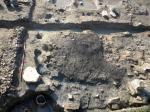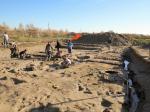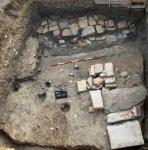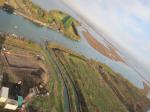Summary (English)
The archaeological activities (excavation, archaeometric analysis and restoration of the materials), undertaken in Torcello in 2012, represent one of the key moments of the EU-Interreg “Shared Culture” project. This was a joint project run by the Veneto Region and Ca’ Foscari University which chose an area on Torcello Island that was unknown from an archaeological point of view, but at the same time of great importance for the enhancement of the island’s archaeological heritage.
It emerged that the residential structures in this part of the island had undergone a substantial phase of abandonment and systematic robbing, and between the 15th and 16th centuries, there was a clear change in use. Previously residential areas were transformed into fields for agriculture. This appeared to correspond with the definitive transfer of the majority of the population from Torcello to Mazzorbo and Burano.
Between 1300 and 1500, the area was densely populated and appeared like a small city suburb. Houses and courtyards were organised around a central element, a_ campiello_ (small square) in the middle of which was a Venetian well. The large well was made entirely of reused Roman materials, probably from nearby Altino. Negative structures (foundations and robber trenches) were uncovered around the well. A series of high-quality timber houses faced onto the square (10th-11th centuries). There were substantial structural traces of these buildings, which have been reconstructed as two-storey houses with four rooms, the lower two probably used for storage. There were courtyards between the buildings in which open-air activities took place. Furthermore, each building faced onto water, the only means of communication between one sector of the city and another.
The earliest phases in this area, dating to central medieval period, were attested by a productive structure, a small kiln that was badly cut by later structures.A second trench revealed a rather complex early medieval stratigraphy. A timber hut (post holes) with a large rectangular hearth made of clay and reused bricks overlay the abandonment layer of an earlier, somewhat monumental, building of more “classical” type, with substantial stone foundations and walls of reused brick (Roman). The building had a portico of columns built in semicircular bricks. It seems to date to the first half of the 7th century. It stood on the side of a canal and mooring structure formed by large calcareous stones: this would seem to indicate that it was a warehouse.
The porticoed building cut into an earlier structure, a structured quay datable to the 1st century A.D., with evidence of occupation until the end of the 2nd century A.D. (amphorae, domestic pottery, food remains).
The third excavation area, situated away from the church of Santa Maria Assunta, also revealed a series of medieval houses. These were masonry built with clay floors and walls, overlying early medieval houses with timber walls, clay floors, and hearths at floor level. The evidence indicated dense settlement in the area.The archaeological activities (excavation, archaeometric analysis and restoration of the materials), undertaken in Torcello in 2012, represent one of the key moments of the EU-Interreg “Shared Culture” project. The project was conceived and undertook jointly by Veneto Region Council and Ca’ Foscari University.
In Torcello archaeologists, archeometres and restorers worked side by side, with two main purposes. On the one hand, the activities were intended to reconstruct carefully the archaeological history of the island, on the other hand the main aim was an high formation for young professionals in the cultural heritage field.
The excavation has concerned a part of the settled area of the late antique and early middle ages of the Torcello island. Torcello is one of the key sites in order to study the problem of the origin of Venice.
In the large field next to the Basilica, during the 2012-2013 excavation, a portion of a residential district was excavated. The area was densely populated with houses and courtyards organised around a central courtyard, almost a ‘campo’ or ‘campiello’. The courtyard featured a Venetian cistern-well, serving as a large water supply system. The well structure was completely made from re-used material dating from the Roman Age.
Around the well, the a residential area was brought to light. The oldest settlement phases, from the 10th to the 11th century, describe this sector with a quite regular layout. Wooden single-family houses characterised by high quality construction overlooked the campo. These were two-storey buildings with four rooms; the two rooms on the ground floor were used as stores for craftsmanship/trade activities, and contained the hearth. The hearth, built on the ground on top of an insulating clay layer, was used for cooking food and heating. It was likely that the rooms on the upper floor were reserved for the family.
Private courtyards used for outdoor activities separated one building from another. Furthermore, each building overlooked the water and had the main gate onto the water: canals were the only communication route between one sector of the city and the other.
According to sources, the trade activities carried out by the Venetic merchants in the Mediterranean and Adriatic scene have aroused the interest the kingdoms and the people of the Po Valley hinterland since the beginning.Trade was the main activity. In addition to ceramic fragments, a tangible sign of these trade activities are the presence of a warehouses. In 2012, excavations unearthed a part of one of the oldest stores (6th to 7th century), built from re-used building material, with a portico on the façade and directly overlooking the canal. The warehouse served to conserve the goods after they were unloaded from the ships that sailed the Adriatic and the Mediterranean seas, before being distributed on lighter boats along the waterways of the hinterland. Furthermore, the stores were probably also used to hold products during seasons (especially winter) when river navigation was prevented by weather conditions.
The 2012 excavations provide information for preliminary idea of the number of inhabitants. The features of the excavated dwellings can establish approximately the average surface area of a house between the 10th and 11th century. With regards to the total 32 hectares available on the islands of Torcello, Mazzorbo and Burano hypothetically for settlement, only a little less than 5 hectares could realistically be used for settlement. No more than 600 dwellings can be calculated over 5 hectares, which implies a variable number of 1,500 – 2,000 inhabitants. A number truly considerable for that time.
- Diego Calaon, Università Ca’ Foscari di Venezia
Director
- Diego Calaon- Università Ca’ Foscari di Venezia
Team
- Manuela Sgobbi- Università Ca’ Foscari - Venezia
- Michele Maritan- Università di Padova
- Alessandro Asta- Soprintendenza Archeologica per il Veneto
- Aleks Pluskowski- Univeristà di Reading, UK
- Krosh Seetah- Università di Stanford, USA
- Elisabetta Zendri- Università Ca’ Foscari - Venezia
- Guido Biscontin- Università Ca’ Foscari - Venezia
- Camilla Sainati- Deadalo snc. Padova
- Alessandra Marcante- Università di Padova, Regione Veneto
- Paolo Mozzi - Università degli Studi di Padova - Dipartimento di Geoscienze
- Malaguti Chiara- Università di Padova, Regione Veneto
- Clara Peranetti- Regione Veneto
- Daniele Scatto- Ufficio del Genio Civile della Regione del Veneto
Research Body
- Regione Veneto, UCPSPC
- Univeristà di Reading
- Università Ca’ Foscari di Venezia, Dip. Ideas, Dip. DAIS
- Università di Padova
- Università di Stanford, USA
Funding Body
- Comune di Venezia
- Progetto Europeo Interreg “Shared Culture”
- Regione Veneto, UCPSPC
- Università Ca’ Foscari di Venezia, Dip. Ideas, Dip. DAIS






![Download [PDF]](/excavation/skins/fasti/images/results/download_sml.png)



